Photo: Courtesy of Toronto FC
Philadelphia Union traveled to Toronto determined to shut down a team that relies extremely heavily on its designated players. Instead, the home side turned the tables and exposed the visitors as entirely dependent on their own designated players for creativity.
A week after floating above the fray with a silky three-assist performance, Cristian Maidana was targeted by the opposition and gave in to his worst tendencies. Toronto looked to squeeze Maidana by playing deep, close lines, and the Argentinian responded by sneaking out to the left for space.
Muzzling Maidana
Maidana’s solution to this particular problem is not necessarily the wrong one, but it served to highlight how inflexible the Union are right now. When Wenger or Le Toux has the ball on the edge, Maidana or Vincent Nogueira reliably shows up as a short option. When the roles were reversed, Philly’s wingers drifted into Toronto’s back line, both limiting Maidana’s options on the wing and playing into the hands of a home side that was willing to grant space in their own half in order to protect the front of their box.
With Maidana’s influence muffled, Toronto showed the league that Philadelphia Union remain severely limited offensively. Lacking a Giovinco-level hybrid playmaker/goalscorer, Philly collapsed under the structure of their own system. The wingers were muted, Nogueira proved that he will only get forward if Maidana is on the ball (a teeth-grinding but understandable strategy, it must be said), and the Union got impatient. Fast.
In essence, Toronto coach Greg Vanney looked at Philly and saw something disturbingly similar to his own side. MaidanaMagic is often not only the best way for Philly’s offense to run, it’s the only way. Without their playmaker on the ball in space, the Union very quickly run out of ideas. The front three tend to drift into the back line while the midfield is forced to play the ball around the horn to fullbacks who struggle to complete passes upfield.
Force play to Gaddis
Toronto trapped the Union in their own shortcomings. Ray Gaddis and Fabinho, even in good form, are inconsistent passers and uncomfortable ball-handlers. Without Maurice Edu to provide quick, accurate passes into midfield, Philly was overly reliant on the limited offensive skillsets of their fullbacks.
And note that this is not a knock on the Union’s fullbacks specifically. Across MLS, finding defenders who are comfortable on the ball is difficult. This is why teams experiment with midfielders in defense (e.g., Orlando City, LA) and rely heavily on deep-lying midfielders with extreme passing ranges (e.g., LA again, NYRB, Toronto with Bradley, and soon NYCFC). Avoiding sideline traps is a necessary component to MLS offensive success in a league where a few teams press well, but every team knows to press the fullbacks.
It would be frustrating to spend another post-match analysis describing how the Union were once again unable to utilize their wide attackers against a narrow defense. But the alternative, to wonder aloud why, yet again, Philly turned into a buzzing, shapeless mess after going behind, is equally unappealing. Both topics have been beaten into the ground as the Union have, again and again, teetered on the cusp of controlling a game before tumbling to a loss after failing to take advantage of their dominance.
Let’s dive into both issues briefly and move on.
Again with the wide guys
Why do the Union’s wide players disappear so often in games? Goalscoring contributions from the wings was supposed to be (needs to be) a hallmark of Philadelphia’s style. The simple fact is that Philly’s best players do their best work outside of the box. This leaves the dirty work of moving and finishing to the front three, and thus far the wide players have been the riddle Jim Curtin cannot solve. During last year’s hot streak, Conor Casey combined well with Le Toux and Wenger to turn a moribund offense into one of the league’s most exciting. The success was so immediate and so well-suited to a club that did not have the money to bring in goalscorers that it became the template Jim Curtin has used ever since.
The thinking has been: Counter quickly and a defense will retreat until the wings have enough space to run at the back line. As effective as this strategy was down the stretch in 2014, it has been found out. The failures and successes of 2015 have come with the wingers largely absent. Eric Ayuk has found success by embracing his unpredictability in comparison to Wenger and Le Toux. The teenager will leave the touchline if his fullback brings the ball forward, he will drift into the box early to pin a defense deep, but retreat to find space again.
Such small adjustments seem simple, but they are not. Especially when players want to recreate the scenarios in which they had the most success. For Andrew Wenger, success came when he played almost a wide target role, pinning his fullback deep, chasing balls into the corner, and attacking the opposition box. Even when he was flying, though, Wenger’s final ball delivery was suspect. And since the goals have dried up, Wenger’s lack of trust in his passing — and the extra touches he takes as a result — have only exacerbated a vicious cycle of low confidence.
On the other side, Sebastien Le Toux is even more of a mystery. The leading goalscorer in club history never connected well with Fernando Aristeguieta and has looked only marginally more comfortable alongside CJ Sapong. It is a testament to Conor Casey’s guile and intelligence that he was at the heart of things when the Union wingers looked their most dynamic last season. And it is a continuing mystery why the wide players have had such trouble adjusting to defenses that force them to join the offense instead of playing as the points of the spear. It is not a simple case of “they are not good enough.” It seems more likely that the rest of the league has posed a problem that Jim Curtin and his staff have yet to solve.
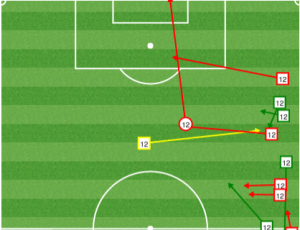
Marky Delgado in May 2014 against the Union. He was pulled at halftime after looking lost for Chivas.
Control then crumble
The Union were the far better team for the first 30 minutes of the match on Saturday. CJ Sapong had two half-chances and a free shot from 20 yards out before Toronto could catch their breath. Prior to going ahead, TFC’s only shot of the match was a wayward attempt from defender Damien Perquis.
Toronto broke through on an undeniably beautiful passing move. The whole of the midfield was involved and it was Jonathan Osorio’s movement that catalyzed the entire play. Osorio picked the ball up wide (in a position similar to where Union wingers often pick it up) and dragged Gaddis inside. Importantly, after handing the ball off, Osorio turned his run into a chance to pop into space in front of the back line, with Marky Delgado drifting to the left. Osorio and Giovinco distracted the central defenders, freezing Ethan White’s eyes on the center of the pitch as Delgado then darted into the box to finish — lucky though that finish was — Giovinco’s final pass. The move featured elements that neither team had displayed up to that point: 1) A wide player pulling his man inside then continuing a run to leave space on the wing, 2) A central midfielder entering the box, and 3) Giovinco.
Prior to putting Delgado through, Giovinco had completed four passes and notched a key pass from a corner kick that landed on Perquis’ head. He was minimally involved, but the price was that Brian Carroll and Vincent Nogueira played deep and took few chances. Giovinco’s was an effect felt by how he influenced the Union without touching the ball; Delgado and Cheyrou were masterful defending Maidana, and the Italian striker deserves a contributing credit for muzzling the Union’s other creator by forcing Nogueira to play even more conservatively than usual.
Overall takeaways
For the Union, the major positive is more proof that they are capable of controlling a game for extended periods of time. Unfortunately, this upshot is indelibly linked to the major negative, which is that without Maidana in top form the Union offense could not find a way through Swiss cheese.
The offensive spacing and movement remains an unresolved issue. Teams that are willing to let Philly huff and puff and wear themselves down continue to find that the Union’s confidence is less secure than a late lead for the Phillies.
As much as it hurts to reduce the Union’s struggles to: Same ol’, same ol’, it is hard to see things any other way. Jim Curtin believes everyone must play well for his team to compete, and he’s half right.
Everyone must play well, but additionally the stars must play like stars. Because without Maidana and Nogueira directing the play, the team tends to go off script.
And the Union need a lot more talent to collect points while improvising. They would need a Giovinco to do that.
Player ratings
Brian Sylvestre – 5
Not a chance on the first, but Sylvestre could have done better with Giovinco’s initial shot on the second goal. Yes, it is easy and correct to blame the Union defenders for freezing, but pushing the ball to either side – or up – is always better than playing poker with a loose ball in the box.
Ray Gaddis – 3
Targeted by Toronto, Gaddis was stuck with the ball at his feet far more often than he or the Union would like. Additionally, Gaddis’ play re-opens a debate on just how aggressive Philly’s fullbacks should be. Gaddis comes has high as he needs to when pressuring the ball carrier, and this can leave gigantic gaps in the left corner. Early in the season, teams exploited Ethan White’s positional follies to attack that space. Since Edu joined the back four, the problem has been less prevalent. Even with Edu returning, the question should be asked: How high up the pitch should the fullbacks go to press? Are the benefits of stepping to Jonathan Osorio 45 yards from goal more than the costs of setting a solid defensive line?
Ethan White – 4
White’s passing was better than his previous outings in back, and positionally he was far more cognizant of the big picture than prior performances would have suggested. If not for Toronto’s well-worked opener, White may have been able to turn this match into a confidence builder. Instead, he will have to be content with his solid showing after he moved to the middle of a back three.
Richie Marquez – 4
A tough night for the rookie as he picked up an injury after doing battle with some big names. The major issue for Marquez — as it was for other Union players — was that he was more focused on Altidore and Giovinco than he was on playing quickly. This is a forgivable sin for a young player, and one he should learn from when he returns from injury and, hopefully, to the starting lineup.
Fabinho – 5
Toronto asked hilariously few questions of Philly’s reborn left back. By deploying four centrally-inclined midfielders, Greg Vanney essentially shrugged and decided to give up the wings in order to shut down the middle. If Giovinco decided to pick on Fabinho, so be it. But he didn’t, and the Brazilian was a peripheral player most of the night. Though he was one of the three players caught staring on Giovinco’s goal. Fabinho was hardly the closest. Still… it looks embarrassing.
Brian Carroll – 5
The question is this: What should Brian Carroll be expected to contribute offensively? Toronto clearly set out to limit Nogueira’s influence on the match. As a result, Carroll was often left in space as Cheyrou stepped to Nogueira and Delgado tracked Maidana. Carroll responded by playing his typical horizontal passing game, albeit with the additional range time granted. Will other teams pick up on this and try to force Carroll onto the ball more?
Vincent Nogueira – 4
In the second half, Nogueira was almost exclusively a side-to-side passer. Most troubling is that this trend continued even after Zach Pfeffer entered the match and ostensibly took up a central role in front of Nogueira. The two never connected and the dynamic movement that freed Nogueira up against Portland never developed.
Andrew Wenger – 2
Almost the definition of uninvolved. Even as the Union dominated the ball for most of the 38 minutes Wenger played, the winger only completed two passes in the offensive half before leaving the match. He had no shots.
Sebastien Le Toux – 4
Le Toux should be the second player in the box on most plays. Against Portland, he would sneak away from his defender at the back post, allowing Nogueira and Maidana to deliver balls across the pitch that put the Union in attacking positions. A deep defensive line, as it has so often, confounded Le Toux and left Philly without a second man in the box most of the afternoon.
Cristian Maidana – 3
It is not that Maidana was that poor. It is that he let himself be pushed out of good positions all night. Perhaps he was carrying a small knock, but regardless of the reason for his anonymity, Maidana showed how important he is to the Union by his creative absence.
CJ Sapong – 6
A shot on frame and a lot of hard work for Sapong. Notably, the striker looked comfortable alongside Conor Casey, suggesting Jim Curtin may be able to consider a 3-5-2 with Maurice Edu in the back without his assistant coaches putting psychiatric services on speed dial.
Substitutes
Eric Ayuk – 5
Another solid showing from the teenager. The willingness to move to get involved continues to distinguish him on the wing. It seems as though every time he enters the match, Ayuk finds himself with a chance from the middle of the box. This leads to the question: Why can’t anyone else find them?
Zach Pfeffer – 3
It’s all there for Pfeffer: The runs into the box that separate him from the rest of the Union midfield, the belief that he can operate in small spaces, and the desire to play in the creative role for a MLS club. Lacking is a consistent run and a secure first touch. Until those two elements are present, Pfeffer may continue in his “on the cusp” role until it is too late.
Conor Casey – 7
A fine goal and good interplay with Sapong suggest Casey could grab more minutes even with Aristeguieta healthy again.
Geiger counter – 4
The 17-9 foul disparity speaks volumes, as Jorge Gonzalez called a fairly good game but failed to properly punish cautionable offenses. Eric Ayuk was fouled six times and no cards came out, and Ashtone Morgan’s late challenge on Sebastien Le Toux was easily bookable as well. But these were not game-changing moments (although Pfeffer getting hauled down in the box could’ve been) and Gonzalez mostly had a solid afternoon overall, particularly by MLS reffing standards.
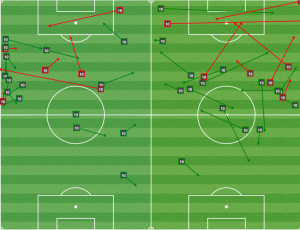
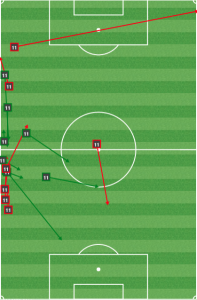
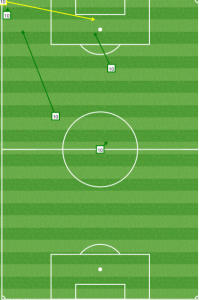
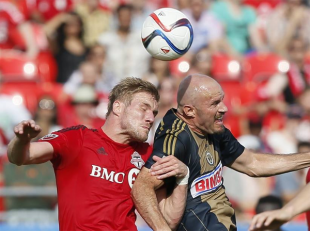

I can’t quite put my finger on any specifics but somehow a lot of the 4’s and 5’s seem a bit high considering how ineffective the team was most of the day. I do agree with the high rating for Casey.
4 and 5’s seem ok it took some level of greatness to beat them but the Union had no greatness themselves.
Greatness is not the word I would use for either of the goals. One was a couple of nice passes and a good finish while the other was simply out hustling the Union to the loose ball. The Union made a number of plays that started out similar to Toronto’s first goal but then continually zigged when they should have zagged or mishandled the pass or whatever.
comparatively speaking and by mls standards great enough. Who else in the MLS could have pulled off Giovinco’s first goal.
I think its time we addressed the Williams Question. As in why isn’t he getting any minutes? Fabhino has had an OK on average run of games but is he seriously a starter now?
.
Early on during the Portland game I found myself wondering wondering if Curtin had made a mistake by not starting him, considering all the space Letoux had on the right side when Maidana reversed the field to him. Surely with Williams bombing up next to Letoux for an overlap the Union could have been doing so much damage. The Union won 3-0 so my question became academic but after the Toronto game I have to wonder. Could Williams at least gave the Union a dimension offensivly that they didn’t have and at least shook things up?
.
ceci est l’ennui et le malaise de l’union
This is exactly right, Curtin backed himself into a corner with Ray being “the right back” and now he has to stick to it. I absolutely love Ray, but this team needs the offensive output from the FBs, especially since Wenger and Letoux continue to not perform.
.
That we continually put out the basic same players/formation/tactics (even though they don’t work except against B squads) speaks to 2 things.
1. The roster is so blatantly subpar and lacking depth.
2. Curtin knows only one way forward and cannot adjust or bench guys not performing.
.
These can both be fixed, unfortunately it won’t be anytime soon.
Point #1 is the depressing one. For the last 8 games or so I complain about the static lineup choices. Then I remember out of a 28 man roster we have basically 14 guys capable/healthy enough to play an MLS game. Even if Curtin had any wild ideas he’s got no choices.
14 is an awfully high number.
I hope Sapong received a bonus point for for the nut shot. The fact he didn’t spend 20 minutes in the fetal position crying like a baby is a testament to his fortitude.
.
I recall one play, I believe it was before the scoring goal. The Union were around the top of the TFC box. I think it was Le Toux – could’ve been somebody else – made a very sweet pass off to the right, putting Maidana all alone in space. And… Chaco flubbed his first touch. I don’t think I’ve ever seen Maidana take a worse touch on a ball, and that play – to me – is a little microcosm if the whole season. So much was done right, but in the end all we can do is watch the ball harmlessly roll away.
.
I’d like to see a 4-4-2 Tuesday. McCarthy; Williams (R), Edu, Vitoria, Gaddis; Noguiera, Maidana, Ayuk, Pfeffer; Fernando, Le Toux. I think slotting Vitoria in between Edu and Gaddis gives the coverage needed for his lack of speed. The midfield is narrow, especially if Pfeffer drifts in off the wing. I think Le Toux can be effective running of Fernando up top. At the 60 minute or so mark, Fernando can be subbed out for Casey if necessary. (This all assumes neither Wenger nor Marquez will be available due to injury.)
How about that lineup but with Fabinho instead of Pfeffer?
I’d be OK with that, too, as long as the coaching staff was reasonably comfortable with Maidana and Noguiera being able to hold possession in the middle. Pfeffer would seem to me to give better opportunity to work short triangle.
.
Like I said, it’s a pretty narrow midfield. Fabinho can definitely address the width issue, but likely at the cost of some possession.
I had the exact same thought about that play. It was a beautiful through ball from Le Toux for Chaco in the 28th minute and he just misplays it and has to chase it wide right and the play fizzles out. I wanted to make a gif of titled “The Union’s Season in 5 Seconds.”
Even an average touch by Chaco on that play gets a shot on goal from a very good position on the field. I’ve never seen him have such a bad touch. He must’ve been surprised somebody other than Noguiera could hit a pass…
This one thing Adam wrote summarizes the whole issue for me:
“without Maidana in top form the Union offense could not find a way through Swiss cheese.”
How is it that Casey, moving at the pace of a Rhinoceros, was able to find the ball move it left and take — and make! — a shot? It’s because he knows how to do it. We don’t have a starter who can create his own chance, a la Giovinco. I’d almost like to see a 4-4-2 with Fernando or Sapong paired with Ayuk. I don’t think this team is built for a 4-4-2, and Ayuk seems to be able to get chances playing fromm the wing just fine, but he’s a green version of what I think this team could use offensively. It is, I suppose, what Toronto is doing with Giovinco and ALtidore paired up top.
Same ‘ol Same ‘ol.
Sorry, I have to disagree with your “5” rating for Sylvestre. The 2nd goal was inexcusable. It’s either a hold (difficult on a dipping half volley), a parry to the side with an open palm, or an underside two-fisted deflection into the ground at a 45 degree angle. Low % play to deflect that shot over the bar. Defenders watched, but 80%+ of that goal was on Sylvestre due to the terrible rebound. He’s a decent stopgap as a GK, but not the long term answer as a starter. Could develop into a good backup option. Should have gotten a “3” rating.
The 4s for LeToux and White were 4 too many. LeToux looked drunk. Can we just admit that DCU got the better of the deal for Parke-White/Edu? Parke not playing is as positive as White playing.
Agreed with LeToux and White. Shoulda had a passing chart for LeToux. Never liked that deal, much rather have Birnbaum or Dean instead of Blake, even with the GK situation.